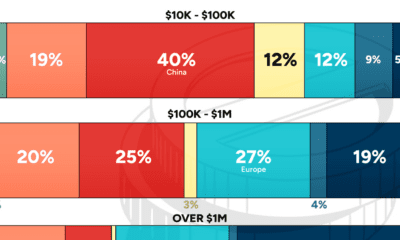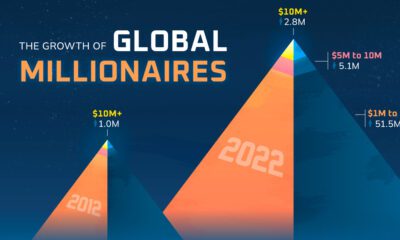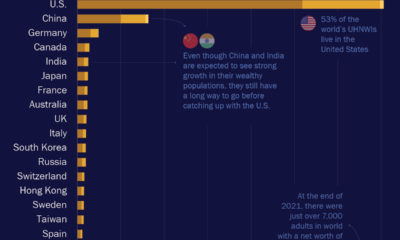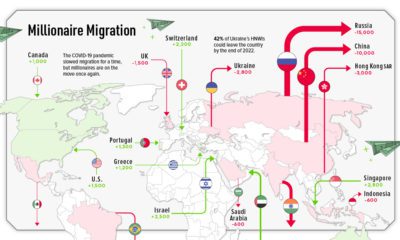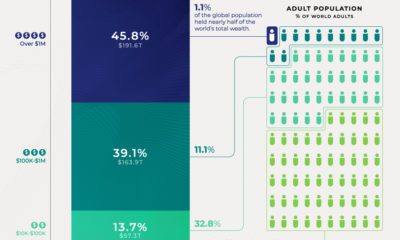Money
Visualizing the Top Countries by Wealth per Person
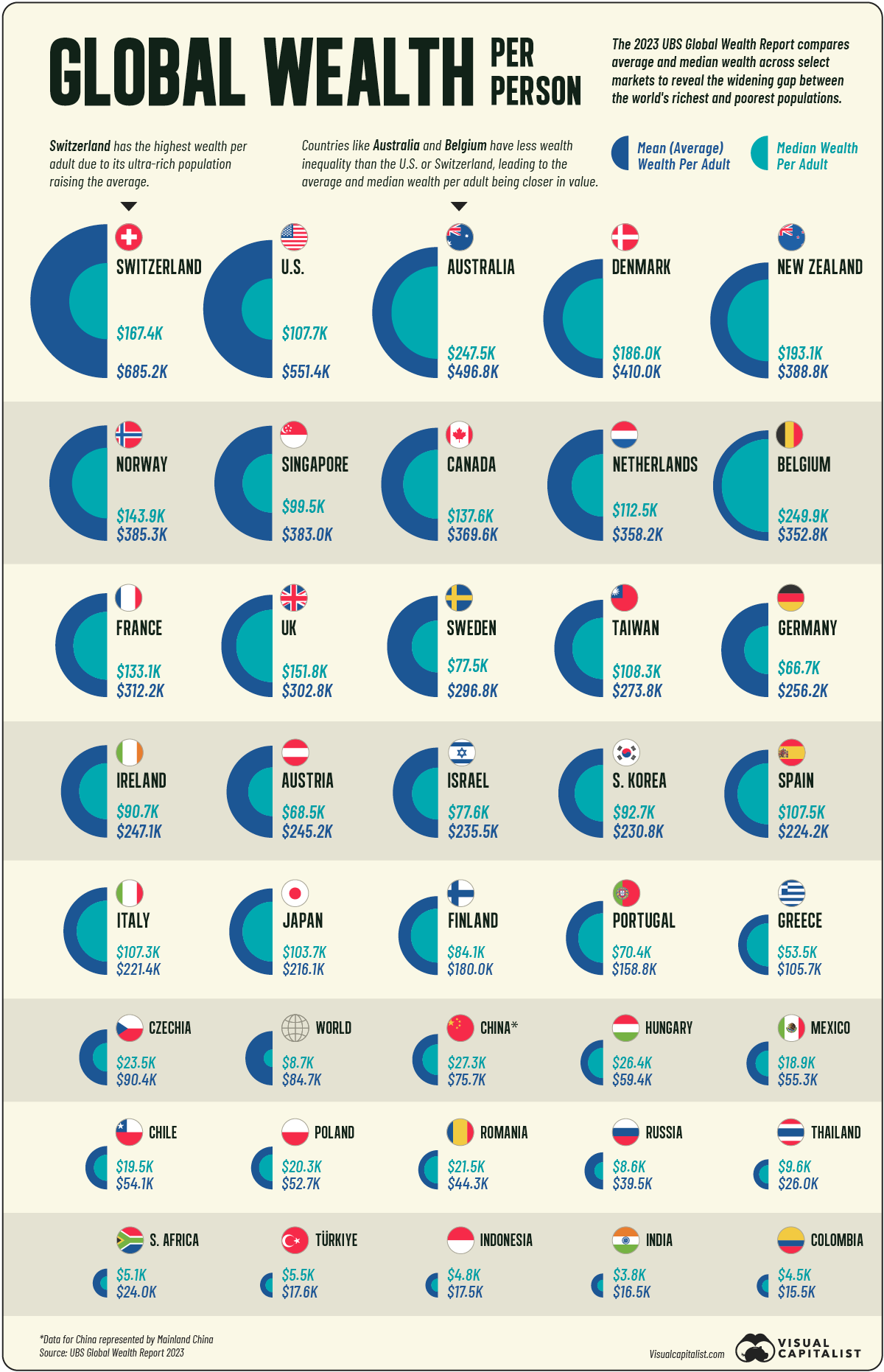
Visualizing the Top Countries by Wealth per Person
When looking at wealth per person on a country-by-country basis, is it more important to look at median wealth or average wealth?
Many experts believe that median wealth provides the most accurate picture of wealth since it identifies the middle point of a dataset, with half of the data points above this number, and half falling below it. In this way, it is less impacted by extreme values, and gives a good representation of the “middle of the pack”.
With that said, average wealth gives you a true average, even though it may get distorted by outliers, like the fortunes held by billionaires.
Either way, today’s graphic compares both average and median wealth across select countries, using data from the 2023 UBS Global Wealth Report.
Top Countries by Average Wealth per Person
In 2022, global average wealth per adult stood at $84,718.
By these measures, Switzerland ranks at the top at $685,226 per person. Over 15% of the population are millionaires, the third-highest rate in the world. However, when looking at median wealth per person, it stands at $167,353, a difference of over $517,000.
Like Switzerland, five of the top 10 countries by average wealth are in Western Europe, including Denmark, Norway, the Netherlands, and Belgium.
The table below shows average wealth per adult in 2022 across 39 countries analyzed by UBS:
| Rank | Country | Mean Wealth per Adult |
|---|---|---|
| 1 | 🇨🇭 Switzerland | $685,226 |
| 2 | 🇺🇸 U.S. | $551,347 |
| 3 | 🇦🇺 Australia | $496,819 |
| 4 | 🇩🇰 Denmark | $409,954 |
| 5 | 🇳🇿 New Zealand | $388,761 |
| 6 | 🇳🇴 Norway | $385,338 |
| 7 | 🇸🇬 Singapore | $382,957 |
| 8 | 🇨🇦 Canada | $369,577 |
| 9 | 🇳🇱 Netherlands | $358,235 |
| 10 | 🇧🇪 Belgium | $352,814 |
| 11 | 🇫🇷 France | $312,235 |
| 12 | 🇬🇧 UK | $302,783 |
| 13 | 🇸🇪 Sweden | $296,800 |
| 14 | 🇹🇼 Taiwan | $273,788 |
| 15 | 🇩🇪 Germany | $256,179 |
| 16 | 🇮🇪 Ireland | $247,080 |
| 17 | 🇦🇹 Austria | $245,225 |
| 18 | 🇮🇱 Israel | $235,445 |
| 19 | 🇰🇷 South Korea | $230,760 |
| 20 | 🇪🇸 Spain | $224,209 |
| 21 | 🇮🇹 Italy | $221,370 |
| 22 | 🇯🇵 Japan | $216,078 |
| 23 | 🇫🇮 Finland | $179,986 |
| 24 | 🇵🇹 Portugal | $158,840 |
| 25 | 🇬🇷 Greece | $105,724 |
| 26 | 🇨🇿 Czechia | $90,393 |
| 27 | 🇨🇳 China | $75,731 |
| 28 | 🇭🇺 Hungary | $59,348 |
| 29 | 🇲🇽 Mexico | $55,274 |
| 30 | 🇨🇱 Chile | $54,082 |
| 31 | 🇵🇱 Poland | $52,741 |
| 32 | 🇷🇴 Romania | $44,320 |
| 33 | 🇷🇺 Russia | $39,514 |
| 34 | 🇹🇭 Thailand | $25,956 |
| 35 | 🇿🇦 South Africa | $23,956 |
| 36 | 🇹🇷 Türkiye | $17,578 |
| 37 | 🇮🇩 Indonesia | $17,457 |
| 38 | 🇮🇳 India | $16,500 |
| 39 | 🇨🇴 Colombia | $15,464 |
| World | $84,718 |
The U.S. falls second, with a mean wealth per adult of $551,347.
Overall, it is home to 38% of global millionaires, outpacing the second-highest country, China, by more than three times. With a significant wealth gap, income inequality in the U.S. is among the highest across developed nations.
Ranking seventh is Singapore, with the highest average wealth per adult across Asia. Income inequality in Singapore falls at a similar level to America based on its Gini ratio.
Top Countries by Median Wealth per Person
Here’s how wealth shifts when looking from a median wealth per adult basis:
| Rank | Country | Median Wealth per Adult |
|---|---|---|
| 1 | 🇧🇪 Belgium | $249,937 |
| 2 | 🇦🇺 Australia | $247,453 |
| 3 | 🇳🇿 New Zealand | $193,065 |
| 4 | 🇩🇰 Denmark | $186,041 |
| 5 | 🇨🇭 Switzerland | $167,353 |
| 6 | 🇬🇧 UK | $151,825 |
| 7 | 🇳🇴 Norway | $143,887 |
| 8 | 🇨🇦 Canada | $137,633 |
| 9 | 🇫🇷 France | $133,137 |
| 10 | 🇳🇱 Netherlands | $112,450 |
| 11 | 🇹🇼 Taiwan | $108,247 |
| 12 | 🇺🇸 U.S. | $107,739 |
| 13 | 🇪🇸 Spain | $107,507 |
| 14 | 🇮🇹 Italy | $107,315 |
| 15 | 🇯🇵 Japan | $103,681 |
| 16 | 🇸🇬 Singapore | $99,488 |
| 17 | 🇰🇷 South Korea | $92,719 |
| 18 | 🇮🇪 Ireland | $90,741 |
| 19 | 🇫🇮 Finland | $84,093 |
| 20 | 🇮🇱 Israel | $77,604 |
| 21 | 🇸🇪 Sweden | $77,515 |
| 22 | 🇵🇹 Portugal | $70,409 |
| 23 | 🇦🇹 Austria | $68,492 |
| 24 | 🇩🇪 Germany | $66,735 |
| 25 | 🇬🇷 Greece | $53,501 |
| 26 | 🇨🇳 China | $27,273 |
| 27 | 🇭🇺 Hungary | $26,416 |
| 28 | 🇨🇿 Czechia | $23,502 |
| 29 | 🇷🇴 Romania | $21,545 |
| 30 | 🇵🇱 Poland | $20,263 |
| 31 | 🇨🇱 Chile | $19,544 |
| 32 | 🇲🇽 Mexico | $18,920 |
| 33 | 🇹🇭 Thailand | $9,602 |
| 34 | 🇷🇺 Russia | $8,595 |
| 35 | 🇹🇷 Türkiye | $5,488 |
| 36 | 🇿🇦 South Africa | $5,141 |
| 37 | 🇮🇩 Indonesia | $4,819 |
| 38 | 🇨🇴 Colombia | $4,450 |
| 39 | 🇮🇳 India | $3,755 |
| World | $8,654 |
Belgium ranks the highest, climbing past Australia for the first time. High home ownership levels and elevated home prices have led household wealth to rise above other European countries.
Median wealth in the U.S. stood at $107,739, falling in 12th place.
Overall, median wealth has grown the fastest in China, increasing eightfold since 2000 to reach $27,273. The country’s rapid economic growth has lifted many into the middle class, yet wealth inequality has also increased.
Biggest Gaps in Average and Median Wealth
Which countries have the starkest difference between average and median wealth per adult?
Across the dataset, the U.S. saw the steepest gap. Median wealth per adult was $107,739—80.5% lower than average wealth levels. This means that wealth ownership skews disproportionately to the country’s richest.
Following the U.S. were South Africa, Russia, and India for illustrating the widest disparities between average and median wealth.
On the other end of the spectrum was Belgium, where median wealth per adult was the closest to average wealth levels. In this way, median wealth per person was $249,937 while average wealth was $352,814, reflecting less disparity.
Other countries with narrower gaps between median and average wealth per person included Greece, the UK, and Australia.
Money
Charted: Which City Has the Most Billionaires in 2024?
Just two countries account for half of the top 20 cities with the most billionaires. And the majority of the other half are found in Asia.

Charted: Which Country Has the Most Billionaires in 2024?
This was originally posted on our Voronoi app. Download the app for free on iOS or Android and discover incredible data-driven charts from a variety of trusted sources.
Some cities seem to attract the rich. Take New York City for example, which has 340,000 high-net-worth residents with investable assets of more than $1 million.
But there’s a vast difference between being a millionaire and a billionaire. So where do the richest of them all live?
Using data from the Hurun Global Rich List 2024, we rank the top 20 cities with the highest number of billionaires in 2024.
A caveat to these rich lists: sources often vary on figures and exact rankings. For example, in last year’s reports, Forbes had New York as the city with the most billionaires, while the Hurun Global Rich List placed Beijing at the top spot.
Ranked: Top 20 Cities with the Most Billionaires in 2024
The Chinese economy’s doldrums over the course of the past year have affected its ultra-wealthy residents in key cities.
Beijing, the city with the most billionaires in 2023, has not only ceded its spot to New York, but has dropped to #4, overtaken by London and Mumbai.
| Rank | City | Billionaires | Rank Change YoY |
|---|---|---|---|
| 1 | 🇺🇸 New York | 119 | +1 |
| 2 | 🇬🇧 London | 97 | +3 |
| 3 | 🇮🇳 Mumbai | 92 | +4 |
| 4 | 🇨🇳 Beijing | 91 | -3 |
| 5 | 🇨🇳 Shanghai | 87 | -2 |
| 6 | 🇨🇳 Shenzhen | 84 | -2 |
| 7 | 🇭🇰 Hong Kong | 65 | -1 |
| 8 | 🇷🇺 Moscow | 59 | No Change |
| 9 | 🇮🇳 New Delhi | 57 | +6 |
| 10 | 🇺🇸 San Francisco | 52 | No Change |
| 11 | 🇹🇭 Bangkok | 49 | +2 |
| 12 | 🇹🇼 Taipei | 45 | +2 |
| 13 | 🇫🇷 Paris | 44 | -2 |
| 14 | 🇨🇳 Hangzhou | 43 | -5 |
| 15 | 🇸🇬 Singapore | 42 | New to Top 20 |
| 16 | 🇨🇳 Guangzhou | 39 | -4 |
| 17T | 🇮🇩 Jakarta | 37 | +1 |
| 17T | 🇧🇷 Sao Paulo | 37 | No Change |
| 19T | 🇺🇸 Los Angeles | 31 | No Change |
| 19T | 🇰🇷 Seoul | 31 | -3 |
In fact all Chinese cities on the top 20 list have lost billionaires between 2023–24. Consequently, they’ve all lost ranking spots as well, with Hangzhou seeing the biggest slide (-5) in the top 20.
Where China lost, all other Asian cities—except Seoul—in the top 20 have gained ranks. Indian cities lead the way, with New Delhi (+6) and Mumbai (+3) having climbed the most.
At a country level, China and the U.S combine to make up half of the cities in the top 20. They are also home to about half of the world’s 3,200 billionaire population.
In other news of note: Hurun officially counts Taylor Swift as a billionaire, estimating her net worth at $1.2 billion.
-

 Debt1 week ago
Debt1 week agoHow Debt-to-GDP Ratios Have Changed Since 2000
-

 Countries2 weeks ago
Countries2 weeks agoPopulation Projections: The World’s 6 Largest Countries in 2075
-

 Markets2 weeks ago
Markets2 weeks agoThe Top 10 States by Real GDP Growth in 2023
-

 Demographics2 weeks ago
Demographics2 weeks agoThe Smallest Gender Wage Gaps in OECD Countries
-

 United States2 weeks ago
United States2 weeks agoWhere U.S. Inflation Hit the Hardest in March 2024
-

 Green2 weeks ago
Green2 weeks agoTop Countries By Forest Growth Since 2001
-

 United States2 weeks ago
United States2 weeks agoRanked: The Largest U.S. Corporations by Number of Employees
-

 Maps2 weeks ago
Maps2 weeks agoThe Largest Earthquakes in the New York Area (1970-2024)

